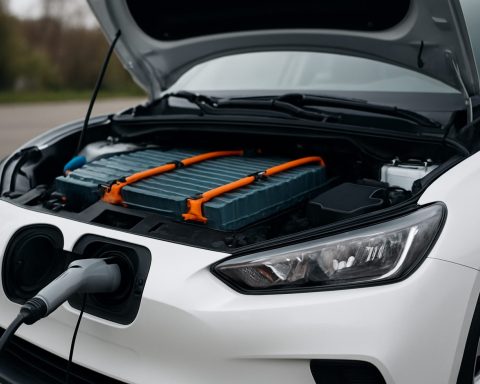- Houston American Energy Corp. is acquiring Abundia Global Impact Group (AGIG) to focus on waste conversion technologies.
- The acquisition reflects a strategic shift from traditional oil and gas to renewable energy, particularly in transforming waste into renewable fuels and chemicals.
- AGIG’s advanced facility in Cedar Port, Texas, is central to this venture, potentially revolutionizing waste management and energy production.
- This move will give AGIG’s stakeholders significant voting power in Houston Energy, accelerating the company’s pivot to green energy.
- Regulatory and shareholder approvals are pending, with excitement mounting about the potential impact on the multi-billion-dollar renewable market.
- The partnership aims to highlight sustainability-driven growth, innovative technology solutions, and strategic commercialization pathways.
- Houston American Energy is poised to contribute significantly to the global shift toward sustainable alternatives.
Dallas streets buzz with the promise of transformation as Houston American Energy Corp. steps into a new frontier, embarking on an audacious journey that could redefine its legacy. In a decisive move, the company has committed to acquiring Abundia Global Impact Group (AGIG), a visionary player in the realm of waste conversion. The stakes are high, but the potential rewards could ripple across industries and redefine how we perceive waste.
Imagine mountains of discarded plastics metamorphosing into streams of renewable fuels and chemicals—this isn’t a future from science fiction, but a tangible reality poised to unfold in Cedar Port, Texas. Here, AGIG’s cutting-edge facility promises to become a nerve center of innovation, propelling Houston Energy into the stratosphere of the multi-billion-dollar renewable energy market.
This acquisition, which will result in AGIG’s stakeholders controlling a significant share of Houston Energy’s voting power, is a gamble on sustainability-driven growth. More than a tactical expansion, it’s a testament to Houston Energy’s bold intent to pivot from traditional oil and gas roots to embrace the burgeoning green revolution.
In the coming months, as the deal clears regulatory and shareholder hurdles, anticipation builds. Industry watchers and environmentalists alike will be keen-eyed spectators as Houston Energy and AGIG forge a structured path forward. With strategic technology alliances and robust commercialization pathways, this partnership could illuminate a new era of fuel and chemical production, supporting the urgent global shift toward sustainable alternatives.
The message is clear: Houston American Energy Corp. is running headlong into the future, armed with innovation, determination, and a vision for a cleaner planet.
Unveiling the Future: How Houston American Energy’s Bold Move Could Transform the Renewable Energy Landscape
How-To Steps & Life Hacks
Transitioning to Renewable Energy Solutions:
1. Research and Understand the Technology: Delve into types of waste conversion technologies, such as pyrolysis and gasification, which are pivotal for transforming plastic waste into renewable fuels.
2. Identify Key Partners and Stakeholders: Develop strategic alliances with technology innovators and environmental agencies to ensure a robust support network.
3. Invest in Infrastructure: Allocate resources to build or upgrade facilities with state-of-the-art technology to maximize conversion efficiencies.
4. Navigate Regulatory Requirements: Work closely with legal teams to meet regulatory standards for environmental impact, safety, and production.
5. Engage in Community Outreach: Educate the local community on the benefits of renewable energy and create transparency in operations.
Real-World Use Cases
Waste Conversion Facilities in Action:
– Plastic-to-Fuel Plants: Companies like Agilyx and Brightmark are already operating facilities that convert difficult-to-recycle plastics into fuels and energy-rich oils, highlighting a scalable model for AGIG.
– Community Energy Projects: Regions that adopt waste conversion technologies have reported reduced landfill use and increased energy security, presenting an attractive case for municipal investment.
Market Forecasts & Industry Trends
Growth Potential in Renewable Energy:
– The renewable energy market is projected to reach $1.5 trillion by 2025 as per a report by Allied Market Research. Houston Energy’s pivot aligns perfectly with this booming trend.
– Waste-to-energy technologies are becoming essential as global waste production is expected to double by 2050, based on a World Bank report.
Reviews & Comparisons
Competitor Analysis:
– Compare Houston Energy’s innovative approach with other industry giants like Neste and TotalEnergies, who are also making strides in the renewable sector through different waste conversion technologies.
– Assess cost efficiency, production capacity, and environmental impact to determine long-term viability.
Controversies & Limitations
Challenges in Waste Conversion:
– Critics highlight potential environmental hazards and energy consumption of waste conversion processes. Studies suggest the need for continuous monitoring and improvement of energy efficiency.
– The financial risk involved in such large-scale operational shifts can also be a concern if the technology fails to deliver on its promises.
Features, Specs & Pricing
AGIG Facility Specifications:
– Location: Cedar Port, Texas.
– Technology Employed: State-of-the-art waste conversion systems that focus on reducing landfill dependency and creating renewable fuels.
– Projected Output: Capable of processing hundreds of tons of waste daily into marketable fuels and chemicals, helping meet rising global demand.
Security & Sustainability
Sustainable Practices:
– By focusing on advanced waste-to-energy technologies, Houston Energy aims to reduce carbon emissions drastically, offering a cleaner, sustainable energy source.
– Commitments to sustainability include using renewable power within facilities and adopting circular economy principles.
Pros & Cons Overview
Pros:
– Reduces dependency on fossil fuels.
– Utilizes waste effectively, reducing landfill impact.
– Promises substantial economic growth and job creation.
Cons:
– High initial investment and operational costs.
– Technical challenges in converting all types of waste efficiently.
– Potential regulatory and community resistance.
Actionable Recommendations
– For Investors: With the potential of the renewable energy market, investing in companies like Houston American Energy could offer significant returns as they pioneer sustainable solutions.
– For Businesses: Emulate Houston Energy’s acquisition model by seeking strategic partnerships with future-forward companies.
– For Individuals: Support initiatives and policies that promote waste conversion projects and renewable energy use.
For more insights on sustainable energy innovations, visit the National Renewable Energy Laboratory.
This bold leap by Houston American Energy Corp. is not merely a business maneuver but a visionary approach towards a sustainable, energy-efficient future. By understanding the intricacies of waste conversion and its broader implications, stakeholders can anticipate and contribute to this transformative journey.



















